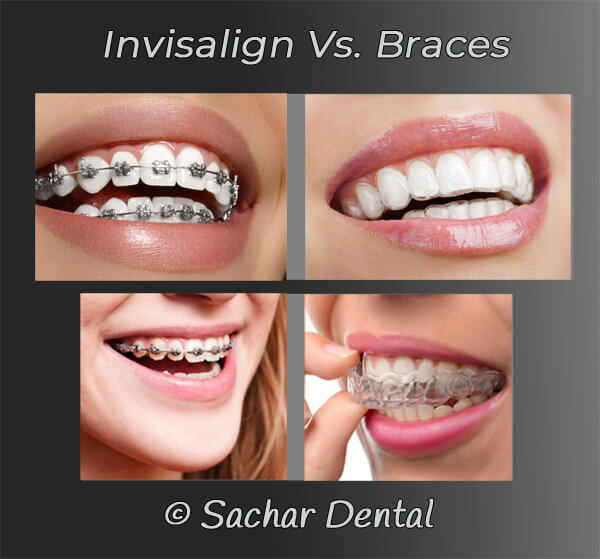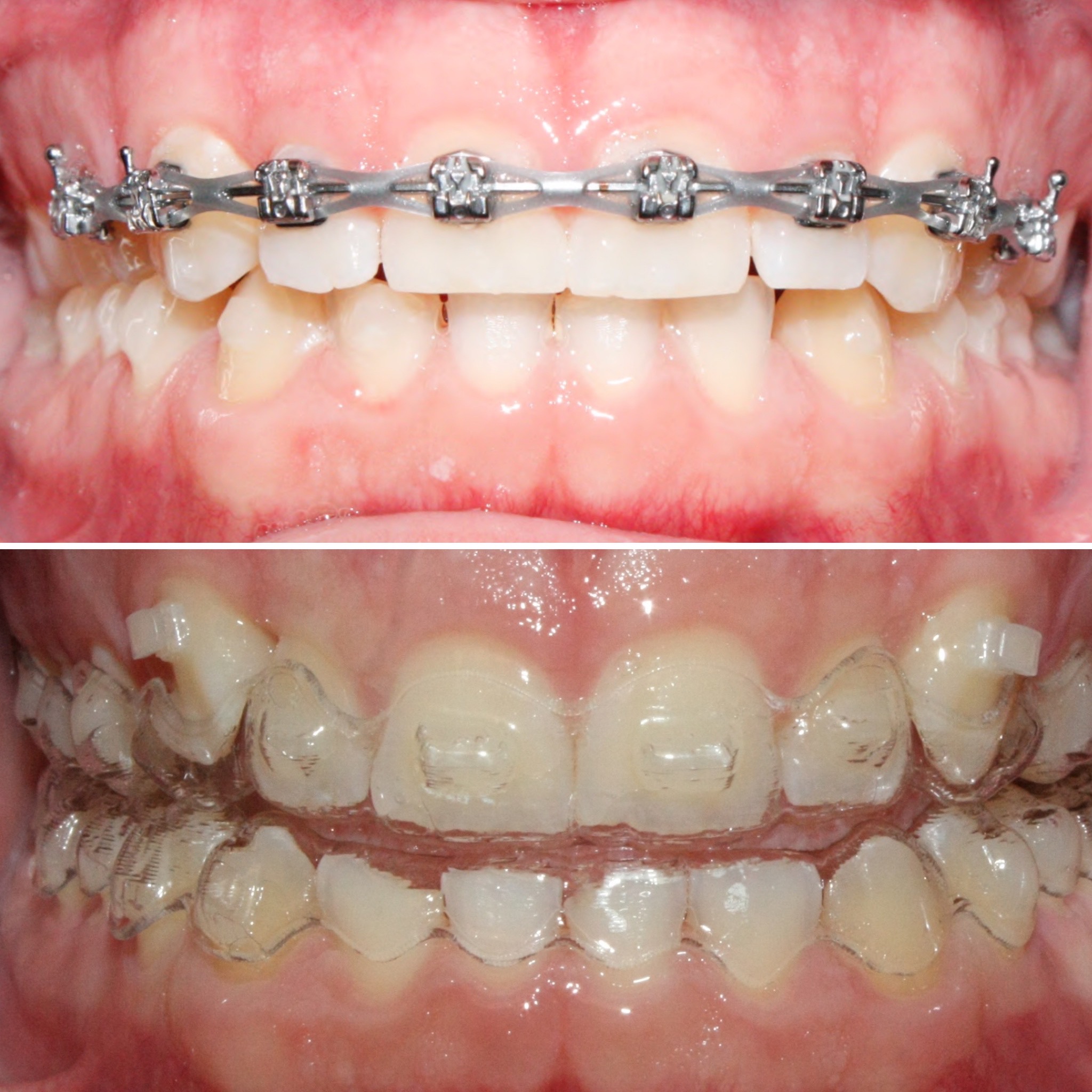The Ultimate Contrast: Invisalign vs. Traditional Dental braces for Grownups
The Ultimate Contrast: Invisalign vs. Traditional Dental braces for Grownups
Blog Article
Invisalign vs. Conventional Braces: Which Choice Is Right for You?
When taking into consideration orthodontic treatment, the selection between Invisalign and conventional dental braces provides numerous crucial aspects that merit careful evaluation. Invisalign supplies a very discreet option with removable aligners, while traditional dental braces offer a more noticeable yet efficient service for extreme imbalance.
Summary of Therapy Choices

On the other hand, traditional braces are composed of steel brackets and cords that are bound to the teeth. This approach applies continual pressure gradually to accomplish placement. While effective for intricate orthodontic problems, typical braces call for normal check outs for modifications and can pose obstacles in maintaining oral health as a result of the trouble of cleansing around cords and braces.
Both options have their advantages, and the selection usually hinges on specific dental conditions, lifestyle preferences, and client compliance. Eventually, getting in touch with an orthodontic professional is crucial for identifying the most appropriate treatment plan tailored to private requirements. Comprehending the nuances of each option can considerably influence the overall success of orthodontic treatment.
Visual Factors To Consider
A substantial aspect influencing the selection between Invisalign and traditional dental braces is the aesthetic allure each treatment offers. Invisalign aligners are crafted from clear plastic, making them basically unnoticeable when worn.
In comparison, conventional dental braces contain steel brackets and cords, which can be much more recognizable. While improvements in orthodontic innovation have actually resulted in the development of smaller braces and colored elastics, typical braces still preserve a more noticeable profile. For some individuals, the presence of braces might discourage them from looking for required therapy.
Inevitably, the choice in between Invisalign and traditional braces might depend upon personal choices regarding aesthetics. Individuals that focus on discretion commonly favor Invisalign, while those who are less worried concerning visibility may decide for typical braces. Comprehending the visual effects of each option is important for making an educated choice that aligns with one's lifestyle and preferences.
Comfort and Convenience

In regards to comfort, Invisalign aligners are removable, enabling people to appreciate their favorite foods without constraint and keep optimal dental health. Brushing and flossing are streamlined, as the aligners can be secured during these regimens, whereas conventional braces need careful steering around cords and brackets.
In contrast, typical braces demand routine adjustments, making them much less practical for those with busy routines. In general, the convenience and benefit of Invisalign make it an enticing choice for several people looking for orthodontic treatment.
Therapy Duration and Performance
While both Invisalign and typical braces work in fixing oral imbalances, the duration of treatment can vary considerably in between the 2 options. Generally, Invisalign therapy can take anywhere from 12 to 18 months, relying on the complexity of the situation. The clear aligners function by gradually moving teeth right into their wanted positions, and routine follow-ups with an orthodontist aid ensure progress stays on course.
In contrast, conventional braces usually require a longer commitment, typically varying from 18 months to 3 years. This is due to their fixed nature and using braces and wires, which can be much more efficient for serious imbalances and complex cases (Invisalign). The treatment effectiveness of standard you can check here braces is well-documented, as they enable for exact modifications and higher control over tooth motion
Inevitably, the selection in between Invisalign and conventional braces may hinge on both the anticipated treatment period and the specific dental concerns handy. Consulting with an orthodontist is critical, as they can give tailored recommendations based on individual needs, ensuring the selected approach aligns with desired results and durations.
Price Comparison and Insurance Coverage Choices
Cost plays a substantial function in the decision-making process for people taking into consideration orthodontic treatment, whether opting for Invisalign or typical braces. Generally, the price of Invisalign ranges from $3,000 to $8,000, while traditional dental braces usually cost in between $2,000 and $6,000. Elements influencing these expenses consist of the complexity of the instance, read more the duration of therapy, and geographical place.
Insurance protection can considerably impact out-of-pocket expenditures. Several dental insurance policy plans supply partial coverage for orthodontic therapies, but the specifics can vary widely. It is vital for clients to assess their insurance coverage plans to determine the degree of coverage for either choice. Usually, standard dental braces may be a lot more regularly covered by insurance coverage strategies contrasted to Invisalign, which some insurance companies categorize as a cosmetic treatment.
Furthermore, several orthodontic practices use flexible settlement plans, making both therapy choices extra easily accessible. Individuals need to ask about prospective financing alternatives and discounts for in advance repayments. Examining the complete cost, including insurance coverage benefits and repayment strategies, is important for making an educated decision that lines up with both aesthetic preferences and budget plan factors to consider.

Verdict
In recap, the choice in between Invisalign and conventional dental braces hinges on numerous elements, consisting of visual preferences, convenience, treatment duration, and price. Invisalign uses a discreet, removable alternative that assists in oral hygiene and nutritional adaptability, while standard braces might be preferable for complicated oral concerns and commonly come at a lower rate point. Eventually, appointment with an orthodontist is important to analyze individual scenarios and establish the most suitable therapy alternative for achieving ideal oral placement.
When thinking about orthodontic therapy, the selection in between Invisalign and traditional braces provides numerous important elements that warrant mindful evaluation.Contrasting Invisalign and traditional braces reveals unique treatment options for orthodontic adjustment.While both Invisalign and standard dental braces are efficient in dealing with oral imbalances, the period of therapy can differ dramatically in between the 2 options.Expense plays a substantial duty in the decision-making procedure for individuals thinking about orthodontic therapy, whether deciding for Invisalign or straight from the source conventional braces.In summary, the option in between Invisalign and conventional dental braces pivots on several variables, including aesthetic choices, convenience, treatment duration, and price.
Report this page